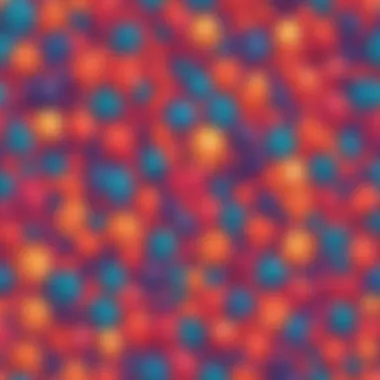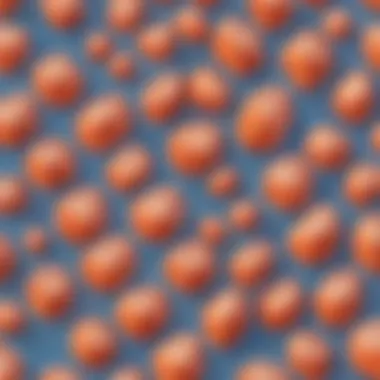Unveiling the Intriguing Geometric Secrets of Polygon Shapes


Creative Activities
In the realm of geometric shapes lies the wondrous world of polygons. These intricate figures with their many sides and angles offer a playground for creativity and exploration. For young minds eager to delve into the realm of geometry, engaging in hands-on craft activities can serve as a gateway to understanding the geometric properties of polygons. From creating paper models of different polygons to designing colorful tessellations, children can embark on a journey of discovery through these interactive craft ideas.
Step-by-step guides play a vital role in ensuring children grasp the concepts behind polygons while having fun. By breaking down complex geometric principles into simple, easy-to-follow instructions, these guides empower young learners to experiment with shapes, sizes, and angles. Whether it's constructing a hexagon out of popsicle sticks or assembling a triangular prism from playdough, each activity presents a unique opportunity for children to engage with polygons in a hands-on manner.
The educational value of these creative activities transcends mere artistic expression. Through crafting various polygon shapes, children not only refine their fine motor skills but also develop a deeper understanding of spatial relationships and mathematical concepts. As they immerse themselves in the process of creating and manipulating polygons, young learners hone their problem-solving abilities and enhance their critical thinking skills, laying a strong foundation for future mathematical endeavors.
Fun Quizzes
To supplement hands-on activities, interactive quizzes provide an engaging way for children to test their knowledge of polygon shapes. Covering a range of topics related to polygons, these quizzes challenge young learners to apply their understanding of geometric properties in a dynamic and stimulating format. By incorporating diverse question types such as multiple choice, true or false, and fill-in-the-blank, these quizzes cater to varied learning styles and foster active participation.
The quizzes available on ElemFun cover an array of exciting topics within the realm of polygons, from basic definitions to advanced properties. By addressing different aspects of polygon shapes through these quizzes, children can expand their knowledge base and reinforce key concepts in an interactive setting. With each question posed, young learners are prompted to think critically, analyze shapes, and make connections between theoretical information and real-world applications.
Knowledge reinforcement lies at the heart of these fun quizzes, offering children a dynamic platform to solidify their understanding of polygon shapes. By engaging with quiz content, young minds have the opportunity to revisit fundamental concepts, identify areas for improvement, and track their progress in mastering geometric properties. Through regular participation in these quizzes, children not only retain information more effectively but also develop a genuine enthusiasm for exploring the captivating world of polygons.
Fact-Based Articles
In addition to hands-on activities and interactive quizzes, fact-based articles serve as valuable resources for deepening children's knowledge of polygon shapes. Covering a diverse range of topics within geometry, these articles present information in a captivating and easy-to-understand manner, catering to young readers' inquisitive minds. By offering detailed explanations, illustrations, and real-life examples, these articles demystify complex geometric concepts and make them accessible to elementary school children.
Topics covered in the articles span a wide spectrum of polygon-related content, including the history of geometric shapes, famous mathematicians, and practical applications of polygons in everyday life. Through engaging narratives and informative texts, children are not only introduced to the rich tapestry of polygon shapes but also encouraged to explore the multidimensional nature of geometry. Supplementary resources, such as links to related articles and external websites, enable young learners to delve deeper into specific topics of interest, fostering a spirit of curiosity and discovery.
By immersing themselves in fact-based articles, children gain a comprehensive understanding of polygon shapes, from their inception to their myriad manifestations in art, architecture, and nature. Armed with this knowledge, young readers are equipped to appreciate the beauty and complexity of geometric forms, paving the way for future explorations in the vast landscape of mathematics and beyond.
Introduction to Polygons
Polygons are fundamental geometric shapes that play a significant role in various mathematical concepts. Understanding polygons is crucial as they form the basis for more complex geometric structures. This section aims to lay a solid foundation by defining and exploring the essential properties of polygons.
Defining Polygons
What Defines a Polygon?
A polygon is a two-dimensional closed figure formed by connecting straight line segments. The key characteristic of polygons is their enclosed shape, with no curves or openings. This aspect is pivotal in understanding the fundamental structure of polygonal shapes. One of the unique features of polygons is their ability to have various sides and angles, making them versatile for representing different geometrical forms. In this article, delving into what defines a polygon provides a structured approach to grasping the fundamental traits of these geometric figures.


Understanding the Boundary and Sides
The boundary of a polygon refers to the perimeter that encloses the shape, created by connecting the sides of the figure. The sides of a polygon are the straight line segments that form the shape. Recognizing the relationship between the boundary and sides is essential for comprehending the overall structure of polygons. By exploring this aspect, we delve into how the sides contribute to defining the shape and characteristics of polygons. Understanding the boundary and sides offers insight into the intricate details that distinguish one polygon from another.
Basic Properties
Vertices and Angles
Vertices are the points where the sides of a polygon meet. These pivotal points determine the shape and structure of the polygon. Angles in polygons represent the directions in which the sides meet at the vertices. The relationship between vertices and angles is crucial in understanding the spatial orientation of polygons. By highlighting the significance of vertices and angles, we can appreciate the complexity and elegance inherent in polygonal structures.
Closed Figures in Space
Closed figures refer to shapes with all the boundaries connected, forming a complete enclosure. Polygons, as closed figures, exemplify this concept with their interconnected sides forming a cohesive shape. Exploring closed figures in space enables us to visualize how polygons occupy spatial dimensions, influencing their properties and applications. Understanding the concept of closed figures in the context of polygons provides a deeper insight into the interconnected nature of geometric shapes.
Types of Polygons
Polygons come in various forms and shapes, each with its unique characteristics and properties. Understanding the different types of polygons is fundamental in exploring the rich world of geometric shapes. By delving into the specifics of regular and irregular polygons, we can grasp the essence of these figures and their distinct attributes. This section serves as a crucial foundation for further exploration into the diverse landscapes of polygon shapes, shedding light on their significance in the realm of geometry.
Regular Polygons
Regular polygons exhibit a high degree of symmetry, making them intriguing subjects in geometric studies. The symmetrical nature of regular polygons contributes significantly to the overall balance and visual appeal of these shapes. Their uniform sides and angles create a sense of harmony and precision, making them ideal for architectural designs and mathematical applications. The key characteristic of symmetry in regular polygons lies in their even distribution of properties, ensuring equidistance between vertices and uniformity in angles.
Examples of Regular Polygons
Examples of regular polygons include familiar shapes like squares, equilateral triangles, and hexagons. These polygons serve as classic representations of symmetry and order in geometry. The uniformity of sides and angles in these examples makes them popular choices for tessellations and patterns in art and design. Their simplicity and versatility make regular polygons essential elements in various fields, enriching our understanding of shape and form.
Irregular Polygons
Irregular polygons deviate from the standardized form of regular polygons, featuring varied side lengths and angles. The irregularity in these polygons adds a level of complexity and uniqueness to their structure, making them intriguing subjects for study. The varied side lengths and angles in irregular polygons offer a diverse range of geometrical possibilities, challenging traditional notions of symmetry and uniformity.
Varied Side Lengths and Angles
The varied side lengths and angles in irregular polygons introduce a sense of dynamism and diversity to their appearance. This variability allows for creative explorations in design and architecture, enabling unique compositions that break away from conventional patterns. While irregular polygons may pose challenges in mathematical calculations, their irregularity sparks creativity and innovation in geometric interpretations.


Distinguishing Characteristics
The distinguishing characteristics of irregular polygons lie in their non-uniformity and asymmetry. These features set them apart from regular polygons, offering a playground for experimentation and artistic expression. The irregularity in these polygons opens up a world of possibilities, inspiring unconventional approaches to shape manipulation and spatial design.
Convex and Concave Polygons
Convex and concave polygons represent distinct categories based on their internal angles and shapes. Understanding the concepts of convexity and concavity enhances our perception of polygons' spatial characteristics and geometric properties. By discerning between these two types of polygons, we uncover essential insights into their structural integrity and aesthetic appeal.
Understanding Convexity
Convex polygons feature interior angles that do not exceed 180 degrees, giving them a 'bulging out' appearance. The concept of convexity emphasizes the outward orientation of these polygons, highlighting their stability and solidity in geometric constructions. Convex polygons play a vital role in architectural blueprints and engineering designs, offering reliable frameworks for building foundations.
Identifying Concave Polygons
Concave polygons, on the other hand, exhibit at least one interior angle exceeding 180 degrees, causing them to 'cave in' towards their center. Identifying concave polygons requires a keen eye for detecting inward-facing angles, which can introduce structural challenges in design and composition. While concave polygons present intriguing geometrical properties, their unique shapes demand careful consideration in spatial arrangements and visual aesthetics.
Properties of Polygons
In the expansive realm of geometric shapes, the exploration of polygon properties holds paramount significance. Understanding the internal intricacies of polygons provides a foundational knowledge base for more advanced geometric concepts. As we delve into the properties of polygons in this article, we aim to unravel the mysteries surrounding the interplay of vertices, angles, and shapes that define these fundamental geometric figures. By examining the structural characteristics and quantitative attributes of polygons, readers are equipped with a holistic perspective on the rigidity and flexibility inherent in these perplexing shapes.
Interior and Exterior Angles
Sum of Interior Angles Formula
Within the realm of polygon properties, the Sum of Interior Angles Formula stands as a cornerstone concept, elucidating the relationship between the number of sides and the total interior angles within a polygon. This formula, indicative of the summing method for interior angles, offers a concise and systematic approach to calculating the total internal angles of any polygon. Its utility extends beyond mere calculation, serving as a fundamental tool for geometric analysis and theorem derivation. The beauty of the Sum of Interior Angles Formula lies in its simplicity yet profound implications, making it a quintessential element in geometric discourse.
Relationship with Exterior Angles
In tandem with interior angles, the relationship with exterior angles in polygons adds another layer of complexity and depth to geometric exploration. This interplay between interior and exterior angles elucidates the spatial dynamics inherent in polygons, shedding light on the symmetrical properties and angular dependencies within these multifaceted shapes. By understanding how exterior angles relate to interior angles, readers are poised to navigate the intricate web of geometric theorems and constructions with clarity and precision. The examination of this relationship offers a nuanced perspective on the holistic nature of polygons, underscoring the interconnectedness of various geometric elements.
Diagonals of Polygons
Calculating Diagonal Count


When delving into the realm of polygon diagonals, the calculation of diagonal count emerges as a crucial point of analysis and understanding. By discerning the specific formulae and methodologies for determining diagonal counts in polygons, readers are equipped with the tools to unravel the geometric complexities inherent in these multifaceted shapes. The ability to calculate diagonal counts not only enhances one's geometric acumen but also unveils the underlying symmetrical patterns and structural symmetries that define polygons. Through a systematic approach to calculating diagonal counts, readers can unveil the hidden intricacies and geometric symmetries embedded within polygons.
Diagonals in Regular vs. Irregular Polygons
A comparative analysis of diagonals in regular and irregular polygons offers a nuanced exploration of the structural differences and symmetrical variations prevalent in geometric shapes. By contrasting the diagonal patterns in regular and irregular polygons, readers gain insights into the varying degrees of symmetry and regularity exhibited by these geometric figures. This comparative analysis sheds light on the unique characteristics and properties of regular and irregular polygons, facilitating a deeper understanding of the geometric nuances that delineate these diverse shapes. Through a meticulous examination of diagonals, readers can appreciate the inherent complexities and symmetrical variations that define polygonal structures.
Special Polygon Shapes
Special Polygon Shapes play a crucial role in the exploration of geometric properties in this article. By delving into the unique characteristics and structures of these polygons, we uncover a wealth of knowledge that contributes to our understanding of the intricacies of polygonal shapes. A focus on Special Polygon Shapes allows us to grasp the symmetrical complexities and spatial relationships that define these particular geometries, offering valuable insights into their applications across various fields and disciplines.
Equilateral and Equiangular Polygons
Defining Equal Sides and Angles
Exploring the concept of Defining Equal Sides and Angles provides a foundational understanding of the symmetric nature of polygons. This aspect emphasizes the balanced proportions and uniformity present in these polygons, showcasing how equal sides and angles contribute to the overall integrity and stability of the geometric form. The distinct feature of Defining Equal Sides and Angles lies in its ability to instill precision and uniformity in polygonal structures, serving as a fundamental element in the study and analysis of polygon shapes within this article.
Role in Geometric Symmetry
The Role in Geometric Symmetry within Equilateral and Equiangular Polygons highlights the importance of symmetry in geometric configurations. This particular aspect accentuates how symmetrical properties enhance the visual appeal and structural coherence of polygons, underscoring their significance in geometric studies. By exploring the Role in Geometric Symmetry, we gain a deeper appreciation for the visual harmony and mathematical precision that characterizes equilateral and equiangular polygons within the context of this article.
Quadrilaterals
Characteristics of Quadrilaterals
The investigation into the Characteristics of Quadrilaterals sheds light on the diverse attributes and properties of these four-sided geometric figures. This aspect accentuates the unique features and structural qualities that define different types of quadrilaterals, elucidating their role in geometric analyses and studies within this article. By examining the distinct characteristics of quadrilaterals, we can discern the varied nature and versatility of these polygonal shapes, offering valuable insights into their applications and significance in geometric explorations.
Types of Quadrilaterals
Exploring the Types of Quadrilaterals enriches our understanding of the different classifications and categorizations within this specific polygonal category. This aspect highlights the diverse typologies and geometric variations present in quadrilaterals, showcasing the distinct attributes and defining characteristics that differentiate one type from another. By delving into the unique features of different quadrilaterals, we can discern the specific qualities and geometric properties that contribute to their classification and identification, providing a comprehensive overview within this article.
Polygons in Real-World Applications
Architectural Designs
Examining the role of Architectural Designs in polygon shapes illuminates the practical applications and creative manifestations of geometric principles in architectural practices. This aspect emphasizes how geometric concepts and polygonal structures inform architectural design decisions, showcasing the interplay between mathematical precision and aesthetic expression in real-world constructions. By delving into Architectural Designs, we gain insights into how polygons are utilized in architectural planning, illustrating their impact on spatial functionality and visual aesthetics within this article.
Geometric Artwork Interpretation
The exploration of Geometric Artwork Interpretation unveils the nuanced relationship between artistic creativity and geometric concepts in visual representations. This aspect delves into how artists and designers incorporate polygon shapes to convey meaning, evoke emotions, and explore spatial arrangements in their artworks. By analyzing Geometric Artwork Interpretation, we can appreciate the depth of interpretation and artistic expression inherent in geometric compositions, offering a fresh perspective on the intersection of geometry and artistic innovation within this article.







